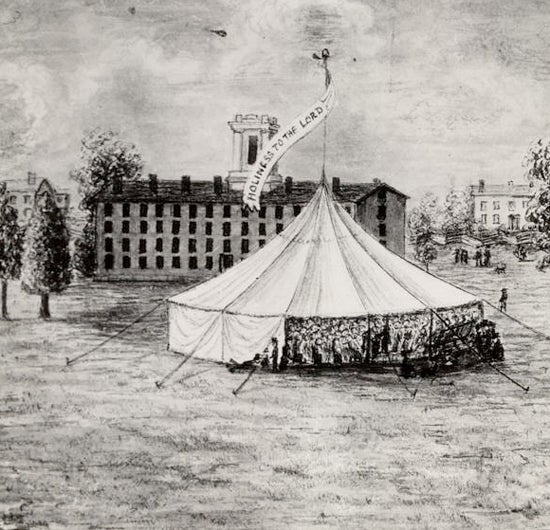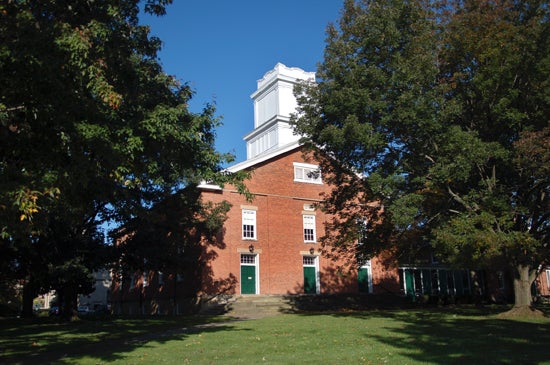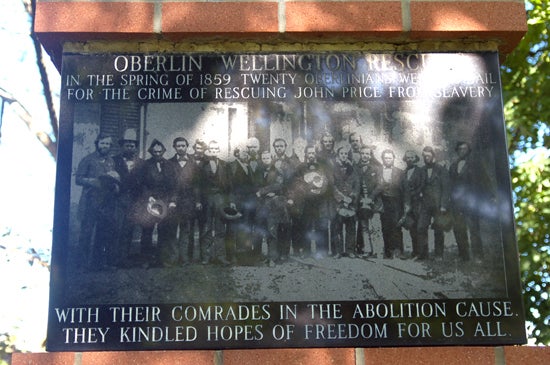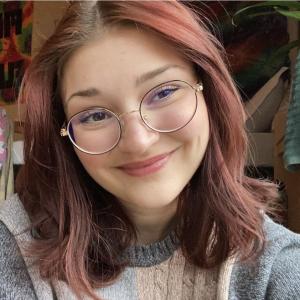Oberlin Blogs
A Stroll Through Oberlin History
October 7, 2009
Ma'ayan Plaut ’10
Welcome to another in the saga of Ma'ayan's unexpected but awesome semester in classes: Oberlin History as American History, where history comes alive.
A preface: I took a history class at community college my senior year in high school. It was free-form "learn the part of history you find interesting" class, and I did learn, but just not conventional history. This worked perfectly well for me, though, since my brain's capacity for memorizing dates maxed out when I did academic team in middle school and part of high school. As I mentioned before, I learn best when things are hands on, and in history, this translates to making history vibrant and personal, rather than something you read in books.
Enter Carol Lasser's Oberlin History class, which I ran across during the fateful add-drop period. Oberlin, in conversation or class title, is a buzzword for me, and I will be lured into classes I never would have thought to put on my scheduling lists, much less actually sign up for. But if being an Oberlin student has taught me anything, you will be pleasantly surprised by the options available and the subsequent decisions made because of them, and tout their lessons from that day forward. Also, I got so many positive recommendations of classes, and that's the second thing I have learned since coming here: take advice on professors and classes and it will serve you well.
Today marked a very exciting day for this class, since we were going on a walking tour through Oberlin's past. We have been learning about Oberlin's beginnings, and its broader relationship with the history of America at the time. Oberlin was started as an institute to train missionaries and teachers, and the town and college began simultaneously, to support and help each other, as a part of the Great Awakening. Among other landmark decisions, Oberlin was founded on learning and labor (Look! Our motto!) and equal opportunities for peoples of all genders and colors.

Fall mornings in Oberlin are gorgeous, but you're usually not expected to walk through them. It was chilly.
We started our walking tour in King, everyone a bit fuzzy and tired and clutching coffee. We had a paper due for this class at midnight the night before, and for once, I managed to turn it in early! I went to bed late for other reasons involving photos and birthday parties. From there, we headed out the eastern side of King into the chilly but sunny fall morning, through the Memorial Arch and onward.


The Memorial Arch has a number of stories associated with it; there used to be a legend that if one walked through it before graduation, the student wouldn't graduate; only at commencement would students pass through. Even then, there was a segment of students who would bypass the arch, because of its implications of the inferiority of the East. Commencement is now held on the far side of Tappan Square, avoiding the Arch issue altogether.
The college used to be situated on Tappan Square, now the nice green square on the eastern part of campus, jointly used for college and community events. The former Tappan Square had living and dining establishments as well as buildings for learning, which Oberlin's students called their home. A spot on the square was also designated the pitching spot for Charles Grandison Finney's revival tent, a prominent location in the small campus's setup. The surrounding land was not the beautiful trees and grass that are currently there, but rather swampland.

Finney's revival tent in Tappan Square. To me, it looks like the circus came to town! (Photo courtesy of the Oberlin College Archives.)
After Tappan, we veered north to First Church of Oberlin. It was, in fact, the first church to be built in Oberlin, and as Carol pointed out, was built to hold a churching mass of 1500... but was built when the current population was only 500. Even in its humble beginnings, our founders had illusions of grandeur. Good thinking, guys.
The outside of First Church is reminiscent of a schoolhouse, and the inside is like a revival tent: seats curved around the pulpit, from which there is a perfect 270 degree view. No one could escape the view of Charles Grandison Finney, and rightly so. Look at his eyes. They're piercing. Finney is like the great-great-great crazy grandpappy of Oberlin, and lends his name to Finney Chapel as well. I could go on about him, but I'll leave Carol Lasser to that.

Carol Lasser, head of the History Department, and queen of Oberlin. Just kidding. The pulpit at First Church makes everyone seem like the top of the world.

First Church, on the outside. It's a stunning building but not oppressive.

Great-great-great grandpappy Oberlin, Charles Grandison Finney. Note that photos back then took upwards of 15 minutes to take, and his eyes are completely sharp and clear. This means he never blinks, and is always looking at you. Be very afraid. (Photo courtesy of the Oberlin College Archives.)


Finney's original bible still stands at the head of the sanctuary... it's ancient and smells delightfully of old book.

In a room right off the sanctuary, there are portraits of all the preachers who had been at First Church. On the far left is our piercing-glare Finney, for whom the church was built.
I love First Church, for similar reasons that I love Finney Chapel. There is no religious paraphernalia around the sanctuary, and its intimate internal setup, controlled acoustics, and amazing light make me feel calm and as about as religious as I can get in my heathen state. The internal architecture is meant to mimic the encircled feeling of the old revival tents.
We then walked by the "gateway" dedicated to Oberlin's acceptance of women. It's not so much a gateway as a small sculpture of sorts, that now leads to the art building. As someone in the class noted, "That doesn't seem like much of a gateway if it leads nowhere." Despite its physical placement, the memorial commemorates an important step in female education.
We continued south on Main Street and ended up at the New Union Center for the Arts, which contains the FAVA gallery and art spaces. The FAVA gallery looks much more church-like, with a steeple and bell tower and curved arching windows. I think the difference between First Church and the education center at the New Union Center lends itself to the relationship between the importance of education and religion, part of the college and town's original missions, and that they are both very much alive still in Oberlin today.

The New Union Center for the Arts is modelled more after a church, though it serves as an educational center. Up until last year, I thought it was a church. My mistake, but an honest one.
We then passed behind the Oberlin Public Library (which Carol noted that it's "the most successful supermarket-turned-public-library" she's ever seen) and walked behind it to see the memorials to the Oberlin-Wellington Rescuers and the obelisk-like statue dedicated to the Oberlin individuals who lost their lives at Harper's Ferry. Condensed versions of these stories: The Oberlin-Wellington Rescue occurred when a group of Oberlinians prevented fugitive slave catchers from capturing John Price, and later helped him escape to Canada, and there were two Oberlinites who raided Harper's Ferry with John Brown (whose father was an Oberlin Trustee), though the plaque adds a few extra names.

Memorial dedicated to the group of Oberlin-Wellington Rescuers.

The Harper's Ferry Memorial obelisk. We sure love statues here in Oberlin.
We then headed east to the War Memorial, commemorating people of all colors for their service in several wars and conflicts. This memorial, unlike one of the memorials on campus, is dedicated to community members who lost their lives protecting their country. At the time of the memorial's construction, it was rare that black service members would be placed on the same memorials.

The War Memorial, much like the New Union Center, mimics church construction, with the curved windows and plain brick construction.
We then headed to the statue of Giles Waldo Shurtleff, advocate for colored people in the military. We shared a few closing remarks before a number of us sprinted back to campus for our 11am classes.


What's he pointing at? Class consensus: the future!
I can only begin to touch on how cool Oberlin history is in this post, so I'm sorry if I've just made you antsy to take Carol's class, even before you've applied to here. It's something to sit in on when you come to visit; we meet Tuesday and Thursday mornings from 9.30 to 10.50am.
Similar Blog Entries
On Living in Oberlin
May 1, 2025
After three months spent studying abroad: what I miss most about Oberlin the town, and Oberlin the college.


Managing an Oberlin Workload
April 25, 2025
All you need to know about the transition from high school to college course work.
